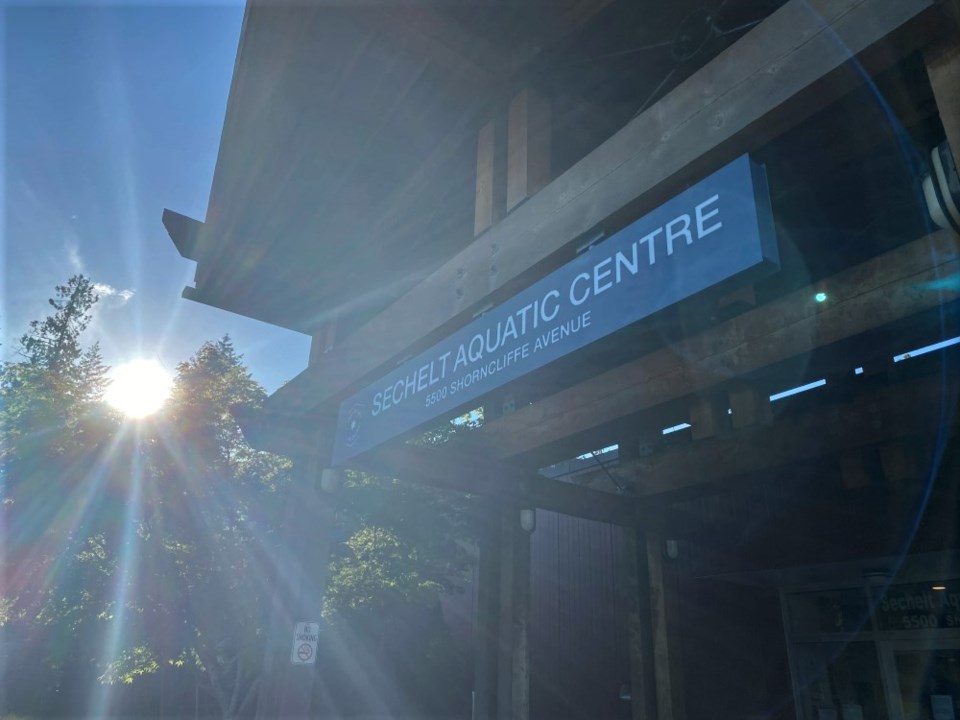Two cooling centres on the Coast are now open to the public, as the lower Sunshine Coast braces for extreme heat this week.
Three local governments on the Coast joined forces to open the centres as of 3 p.m. July 25, providing locations for people to take refuge from the heat and sun:
The Gibsons & Area Community Centre's (700 Park Road) cooling centre can now be found in the lobby from 6 a.m. to 8:30 p.m. on Thursday and Friday, and from 9 a.m. to 5 p.m. on Saturday and Sunday.
In Sechelt, the Aquatic Centre at 5500 Shorncliffe Avenue will host its cooling centre in the swimming pool viewing area from 6 a.m. to 9 p.m. on Thursday and Friday, between 9 a.m. and 6 p.m. on Saturday and 10 a.m. and 4:30 p.m. on Sunday.
On July 28, the SCRD announced the cooling centres will remain open through the weekend, extending the original plan of keeping them open through Friday.
Both locations provide air conditioning, a place to sit, water to drink and information pamphlets on how to deal with the heat. On Tuesday, 11 people used the centre in Gibsons. The Gibsons cooling centre can hold a maximum of 20 people, while Sechelt's can accomodate a maximum of 10. The "SCRD is prepared for a surge in capacity at each of these locations," communications manager Aidan Buckley told Coast Reporter.
Hot temperatures rising
In the early hours of Monday, July 25, Environment Canada issued a heat warning for most of British Columbia and advised people to take precautions this week.
“Threat: Daytime high temperatures 31 to 35 degrees Celsius inland and 25 to 29 degrees Celsius near the water. Early morning low temperatures 15 to 17 degrees Celsius.”
That threat began July 25 and could last as long as Friday or Saturday before a slow cooling trend the following weekend, Environment Canada predicts. The heat will ramp up from a daytime cool near sunrise to the hottest time of the day in late afternoon and early evening, with Wednesday through Friday expected to see the peak high temperatures.
The entire Sunshine Coast region is expected to see the high temperatures, as well as Metro Vancouver, much of Vancouver Island, the Fraser Valley, the Howe Sound and Sea to Sky region, and Southern Gulf Islands. A map accompanying the warning shows red across the majority of the province.
Environment Canada’s warning says people should watch for the effects of heat illness and be prepared. While risks are greater for people with chronic illnesses, young children, pregnant women, older adults (65+), people with substance use issues, people with mobility issues, and people outdoors, “Extreme heat affects everyone.”
More information about heat-related illnesses can be found at www.healthlinkbc.ca/healthlinkbc-files/heat-related-illness, Vancouver Coastal Health's http://www.vch.ca/public-health/environmental-health-inspections/healthy-environments/climate-change-and-health/extreme-heat or by calling HealthLinkBC at 811.
Heat response plan activates
As of Monday morning, the Sunshine Coast Regional District (SCRD) has activated its heat response plan, the regional district’s communications manager Aidan Buckley told Coast Reporter. The District of Sechelt, Town of Gibsons and SCRD use a team approach, as the municipalites typically supply the venues and the SCRD runs the service.
In Gibsons, the Town also directs people to the Gibsons Public Library and Sunnycrest Mall during their regular operating hours.
The District of Sechelt also shared some tips for keeping cool:
- Keep windows open all night, and close some by 10 a.m. to trap the cool air inside
- Close curtains or blinds throughout the day
- Use fans, take a cool shower or wear a wet t-shirt at home
- Find cool places outside. The district notes Hackett Park, Mission Point Park and Snickett Park all have shaded areas and often a breeze
- Find a cool place inside, such as the library, rec centre or mall.
- Limit physical activities outside, especially in the afternoon
- Stay hydrated
- Monitor for signs of heat exhaustion or heat stroke (fainting, drowsiness, confusion, lack of coordination and very hot or red skin
Last year, the lower Sunshine Coast saw heat break decades-old records. On June 26, 2021, both Sechelt and Gibsons recorded new highs of 36.9 degrees — smashing the previous record of 35.6 C set in 1965. (Records in Gibsons have been kept since 1949 and in Sechelt since 1956.) The new record lasted less than 24 hours. The very next day, temperatures soared to 39.6 degrees. But it didn’t stop there. On June 28, 2021, the record was broken yet again when the mercury hit a whopping 40.8 degrees celsius.
During the 2021 heatwaves, the spike in water consumption pushed the Chapman Creek Water Treatment Plant and other water infrastructure to maximum capacity, putting a strain on the then-already strained resources. In the July 25 press release, the SCRD also asks residents to be mindful of their indoor and outdoor water use in the coming days. Stage 2 water conservation regulations take effect July 28 for both Gibsons and the Chapman Water System, with South Pender Harbour users following the next day, when high temperatures are expected to hit.
With files from Sophie Woodrooffe


.jpg;w=120;h=80;mode=crop)
